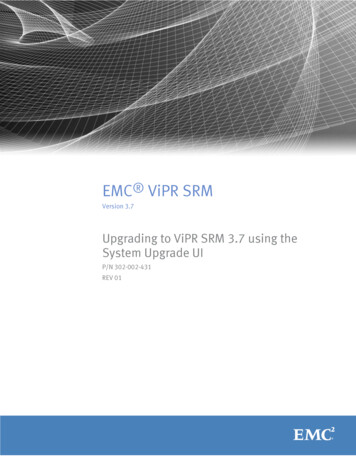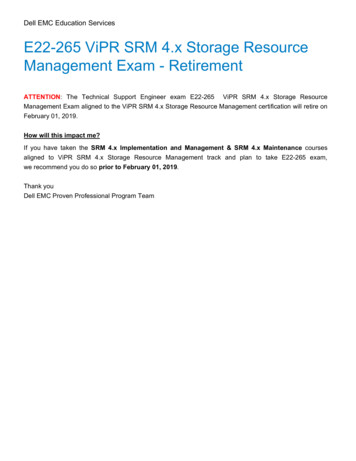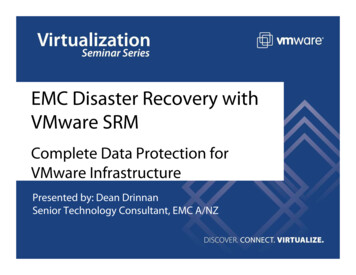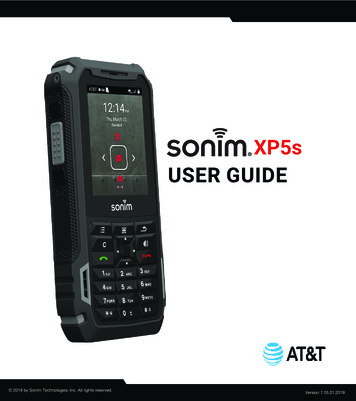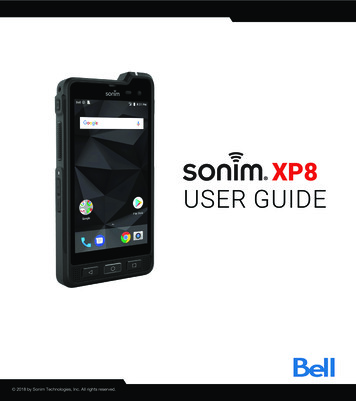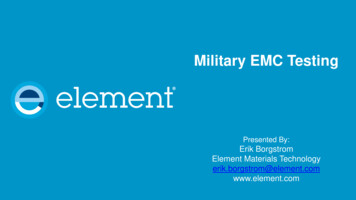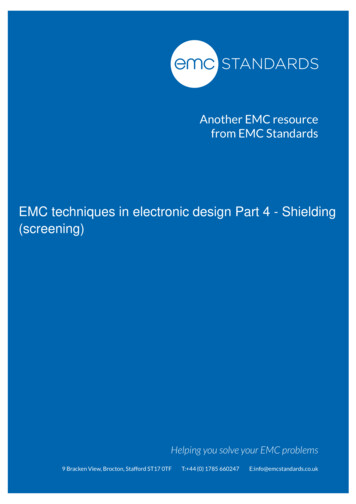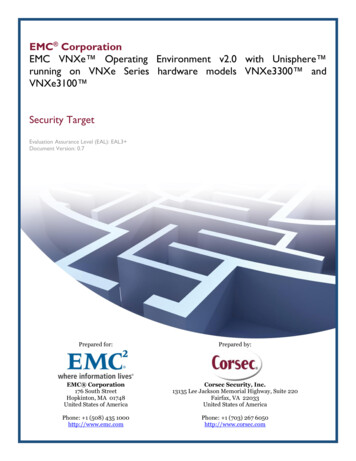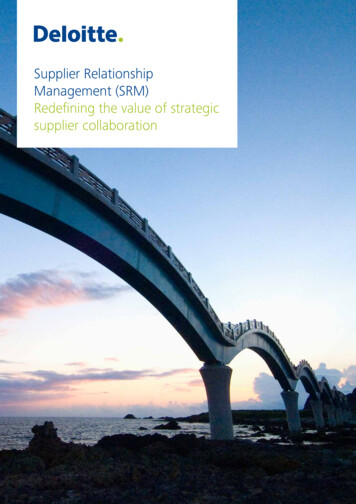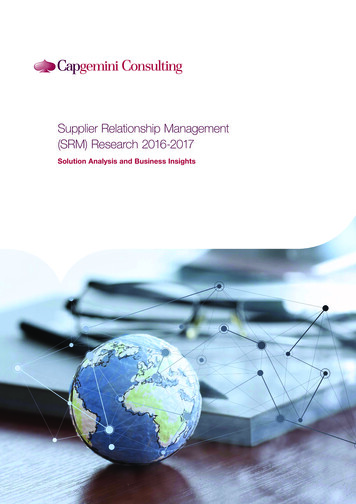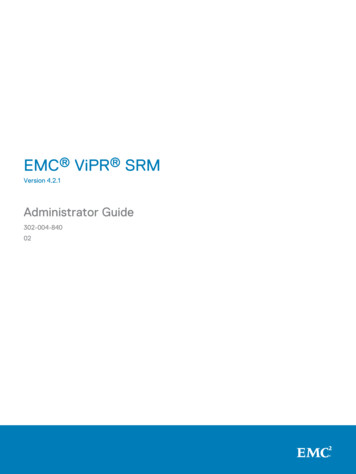
Transcription
EMC ViPR SRMVersion 4.2.1Administrator Guide302-004-84002
Copyright 2015-2018 Dell Inc. or its subsidiaries All rights reserved.Published April 2018Dell believes the information in this publication is accurate as of its publication date. The information is subject to change without notice.THE INFORMATION IN THIS PUBLICATION IS PROVIDED “AS-IS.“ DELL MAKES NO REPRESENTATIONS OR WARRANTIES OF ANY KINDWITH RESPECT TO THE INFORMATION IN THIS PUBLICATION, AND SPECIFICALLY DISCLAIMS IMPLIED WARRANTIES OFMERCHANTABILITY OR FITNESS FOR A PARTICULAR PURPOSE. USE, COPYING, AND DISTRIBUTION OF ANY DELL SOFTWARE DESCRIBEDIN THIS PUBLICATION REQUIRES AN APPLICABLE SOFTWARE LICENSE.Dell, EMC, and other trademarks are trademarks of Dell Inc. or its subsidiaries. Other trademarks may be the property of their respective owners.Published in the USA.EMC CorporationHopkinton, Massachusetts 01748-91031-508-435-1000 In North America 1-866-464-7381www.EMC.com2EMC ViPR SRM 4.2.1 Administrator Guide
CONTENTSFigures7Tables9Chapter 1ViPR SRM introduction11System description. 12Log on and explore the ViPR SRM Interfaces.14Provide an enterprise logo and message. 16Configuring an SMTP server . 17Navigation styles . 17Set the navigation style.18Make icon navigation column static.19Use links in reports to get more detail . 19For more information. 23Chapter 2Manage users, profiles, roles, and authentication25User management. 26View and edit existing user accounts . 26Add a user .27User authorization. 30Delete a user.30Test user settings.31View and edit profiles. 31Create new profiles and assign users to profiles . 32View and edit roles. 35Create roles and assign users to roles.36Authentication and realms.41Add new realm. 42Prioritizing authentication realms. 43Local realm. 43Configuring an LDAP server for authentication.43Configuration properties for LDAP authentication.45Adding external members to a role.48Adding external members to a profile. 48More security information. 49LockOutRealm and RoleLock.49Chapter 3Manage ViPR SRM processes and scheduled tasks51Starting and stopping processes . 52Access configuration and log files for system processes. 53Check status of all processes. 54Stopping processes on the command line.56Stopping EMC M&R platform services on a UNIX server. 56Stopping EMC M&R platform services on a Windows server. 56Access and configure scheduled tasks. 56Metrics collection and reporting. 57Collectors and metrics. 57EMC ViPR SRM 4.2.1 Administrator Guide3
CONTENTSConfigure the import variable status task.58How ViPR SRM handles collection interruptions. 60Monitoring for collection interruptions. 62Isolated causes of reporting gaps . 64Chapter 4Routine maintenance and health checks67Quick access to serious infrastructure alert details. 68System health checks.70Web server health.70Services health.71Server disk space.72Database health. 72Backend servers health.73Collector managers . 74Server CPU and swap space. 74Temporary files.75Check log files. 76Task completion.77Data collection. 78Use alerting reports to monitor system health. 78JVM sizing requirements. 80Backup and restore. 80Chapter 5Occasional administrative tasks81Tasks after new SolutionPack installations. 82Saving Display settings. 82Exclude maintenance period from report totals. 83Chapter 6Update and expand ViPR SRM85Online Update overview.86Configuring server settings for online updates. 86Enabling the online update task. 86Running the online update task manually. 87Online Update Status.87Online Update History. 89Disabling the online update task. 89Updating SolutionPacks. 89Overview. 89Upgrading all SolutionPacks and other components. 89Updating SolutionPacks and other components. 91Adding new components.93Expand reporting capabilities with additional SolutionPacks.93Plan for future growth.93Chapter 7Licensing97Licensing concepts. 98After installation: Licenses and SolutionPacks. 98EMC M&R feature names and ELMS licenses. 98Trial licenses. 98License duration. 99License purchase. 99Licensing operations.99Log in with admin credentials. 994EMC ViPR SRM 4.2.1 Administrator Guide
CONTENTSView license information. 100Upload a new license file. 102Delete licenses. 103Synchronize licenses on multiple hosts. 103Troubleshooting licensing .104Permanent license stops working after host reconfiguration.104Users are locked out of ViPR SRM. 104Module does not start or has no license . 107ELMS license entitlements. 107Chapter 8EMC Secure Remote Support (ESRS)109Troubleshooting procedures115EMC Secure Remote Support (ESRS). 110EMC Secure Remote Support overview.110Configuring ESRS. 110Running and scheduling the ESRS task. 111Configuring an SSL truststore. 111Configuration information sent to EMC via ESRS. 112Alerts sent to EMC via ESRS. 114Chapter 9General recommendations for customer troubleshooting. 116SSL certificates. 116SSL certificate error examples.117Troubleshooting an SSL certificate error: Accepting the exception.117Installing a self-signed SSL certificate from an Internet Explorerbrowser.117Importing an SSL certificate into your truststore.118Exporting an SSL certificate from an Internet Explorer browser.119Troubleshooting . 120What to do if data does not appear in any reports.120What to do if data does not appear in some reports.121Viewing collector errors in the Collector-Manager log files. 121Collecting diagnostics on UNIX. 122Collecting diagnostics on Windows. 122Detect and repair database crashes. 122Find the SolutionPack that discovered a device. 124VM Utilities Manager.124VM Utilities Manager overview.124Using the VM Utilities Manager GUI. 125Using the VM Utilities Manager CLI.125Log files.126Chapter 10About the datastore127Overview.128Usage.128SQL syntax. 130EMC ViPR SRM 4.2.1 Administrator Guide5
CONTENTS6EMC ViPR SRM 4.2.1 Administrator Guide
FIGURES12345678910ViPR SRM physical architecture. 13ViPR SRM metrics collection. 14Data Collection Issue alerts on the All Alerts report. 64Data Collection Issue alert details. 64Online Update Status.87Online Update Status with a major version update detected. 88Configuring the SolutionPack for EMC M&R Health. 90SolutionPack update incompatible file messages. 91Growth metrics to monitor. 94Finding the collector for a device. 124EMC ViPR SRM 4.2.1 Administrator Guide7
FIGURES8EMC ViPR SRM 4.2.1 Administrator Guide
TABLES123456Role access to report templates. 38Role restrictions and limits. 40Required properties for LDAP authentication . 46Required properties for mapping LDAP groups to roles. 47Reporting results for metric collection gaps. 61Features in ELMS SRMSUITE GENERAL. 107EMC ViPR SRM 4.2.1 Administrator Guide9
TABLES10EMC ViPR SRM 4.2.1 Administrator Guide
CHAPTER 1ViPR SRM introductionThe following topics introduce the ViPR SRM system and its components.lllllllSystem description. 12Log on and explore the ViPR SRM Interfaces. 14Provide an enterprise logo and message. 16Configuring an SMTP server . 17Navigation styles .17Use links in reports to get more detail .19For more information. 23ViPR SRM introduction11
ViPR SRM introductionSystem descriptionViPR SRM provides a multi-vendor view into an enterprise storage infrastructure tohelp visualize and optimize capacity and manage devices.Features for Storage AdministratorsThe ViPR SRM user interface provides a single view of all discovered storage-relatedcomponents in your storage infrastructure. One user interface provides reports thatshow information about storage systems, switches, connection fabric, and hostinitiators. For storage administrators, ViPR SRM provides the following features:lEnterprise wide capacity summary and details.lCapacity planning and forecasting.lService level, replication, and virtual storage reporting.lStorage infrastructure details, including hosts, switches, fabric, and portinformation.lPerformance reporting and analysis.lDetailed component inventories per storage system show, for example, disks, filesystems, volumes, and storage pools.lChargeback reporting.lTopology views showing relationships between components.lConsolidated alerting.lSituations to watch reports to draw attention to developing problems.lCompliance module shows compliance or non-compliance to storage bestpractices and business policies.These and other features for Storage Administrators are documented in the followingguides, available on the ViPR SRM 4.1 Documentation Index:lViPR SRM User Guide for Storage AdministratorslViPR SRM Alerting GuidelViPR SRM Compliance GuidelViPR SRM Data Enrichment and Chargeback GuideFeatures for ViPR SRM System AdministratorsThis guide describes features intended for the administrators of the ViPR SRMsystem. ViPR SRM includes an Administration Interface, which is accessible from theUser Interface. Some of the functions available from the Administration Interface are:lPhysical and logical details about the ViPR SRM system setup.lUser account administrationlProcess managementlFeature configurationlAccess to log fileslSolutionPack installation, configuration, and updatinglDiscovery of new storage infrastructure componentsThe ViPR SRM servers are monitored by the SolutionPack for EMC M&R Health,making the ViPR SRM system self-monitoring. This SolutionPack provides alerting,12EMC ViPR SRM 4.2.1 Administrator Guide
ViPR SRM introductionhealth status and metrics, sizing information, and operational reports for the ViPRSRM infrastructure.Components in ViPR SRMThe typical physical system for ViPR SRM consists of a set of servers or vApps thathost various operations for the system, as follows:FrontendHosts the Tomcat web server and the ViPR SRM Console. Users andadministrators log onto the Frontend server. All Frontend services, includingreports, alerting, and compliance, are integrated into a single User Interface onthe Console.Primary BackendHosts the database and system processes and tasks, including the Alerting,Compliance, and Topology Backend components.Secondary BackendHosts additional backend elements.Collector ManagerHosts the metrics collectors that receive information from the monitored storagedevices.The following figure shows the relationships between these components.Figure 1 ViPR SRM physical architectureLogically, ViPR SRM consists of the core platform ( EMC M&R) and a set ofSolutionPacks installed onto the core that add storage-specific and device-specificfunctionality.SolutionPacks essentially customize the system to your infrastructure—you installonly the ones you need. A SolutionPack installs a metrics collector, reports, alertdefinitions, compliance policies and many other components that enable meaningfulreporting for a storage device type or feature set.When you install a new SolutionPack, you also configure a discovery process to lookfor the new device types. ViPR SRM discovers devices and initiates metrics collectionSystem description13
ViPR SRM introductionfrom them, and those new devices eventually appear in the reporting infrastructure onthe ViPR SRM User Interface.The following figure shows how metrics from various devices are collected, enriched,merged into a single database, and displayed in one user interface. The Load BalancerArbitrator/Load Balancer Connector (LBA/LBC) manages collected data. The data isinserted into the database where it is available to the Frontend for reporting purposeson the Web Portal, whic
12 EMC ViPR SRM 4.2.1 Administrator Guide. health status and metrics, sizing information, and operational reports for the ViPR SRM infrastructure. Components in ViPR SRM The typical physical system for ViPR SRM consists of a set of servers or vApps that
